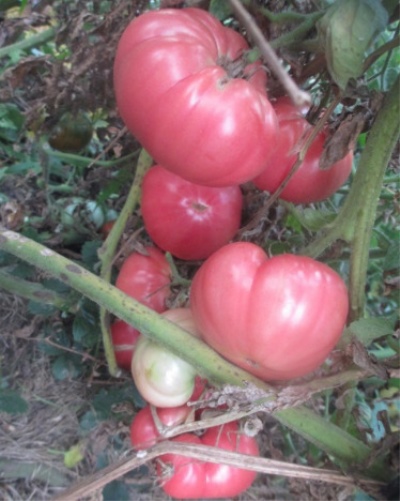
- Authors: Dederko V.N., Postnikova O.V.
- Year of approval: 2014
- Category: grade
- Growth type: determinant
- Appointment: fresh consumption, for pickling and canning, for juice, for ketchup and tomato paste
- Ripening period: late ripening
- Ripening time, days: 118
- Growing conditions: for open ground, for film greenhouses, for greenhouses
- Marketable fruit yield,%: 90,3
- Bush size: medium-sized
The pink Bugai tomato was bred in Siberia. Experts have created a vegetable crop that can be grown in regions with a difficult and unstable climate. Despite the fact that this variety has been known for only a few years, it has already managed to establish itself favorably due to its many positive characteristics.
Description of the variety
A variety with a determinant type of growth is cultivated in greenhouses and in open areas. The harvested crop is used to make sauces, tomato paste, juice and preparations for the winter. During the season, vegetables are eaten fresh. The bushes are medium-sized, reaching a height of 150 to 180 centimeters. Sometimes higher specimens are found. Form the plant into one or two stems. They must get rid of the stepchildren. The inflorescences are simple.
The main qualities of the fruit
The ripeness of the fruit is indicated by a bright pink color, with a spot at the stalk. The sizes are large. The shape is rounded, slightly flattened, with slight ribbing. The pulp is dense, but tender, sugary. There are few seed chambers, as well as seeds.
The average weight is more than 300 grams, but under certain conditions it turns out to grow tomatoes weighing 500-600 grams. There have been cases when it was possible to grow record large tomatoes in a weight of about one kilogram. To achieve these results, you will have to get rid of the extra flowers by removing them. As a rule, the largest fruits are formed on the first fruit clusters.
Taste characteristics
The taste of ripe tomatoes is noted as rich and pleasant. The fruits contain a large amount of sugars and antioxidants, which have a positive effect on the gastronomic qualities of the fruit. The aroma and taste of pink tomatoes is brighter compared to red varieties.
Ripening and fruiting
The ripening period of vegetables is late and totals 118 days. Harvested from July to August. Fruiting is long-term. In areas with short and cool summers, it is recommended to cultivate the variety under cover.
Yield
The yield is quite high. About 4 kilograms of vegetables or 392 centners per hectare are harvested from one bush. The yield of marketable fruits is 90.3%.
Note: ripe Bugai tomatoes are not stored for a long time, so it is advisable to remove them from the bushes as they ripen. If necessary, they can ripen at home.
The timing of planting seedlings and planting in the ground
Sowing seeds for seedlings is carried out in March. Large-fruited vegetable crops are grown by seedlings. Otherwise, in the conditions of a short summer, the tomatoes will not have time to fully form and ripen.
Before germinating seed, prepare the following in advance:
seeds (only a quality product is used, no defects);
priming;
container for seedlings.

Growing tomato seedlings is an extremely important process, because it largely depends on whether the gardener can harvest at all. All aspects must be taken into account, from seedbed preparation to planting in the ground.
Landing scheme
When laying the planting on one square meter of the plot, 2-3 bushes are grown.

Growing and caring
Many gardeners make the soil for growing tomatoes on their own so as not to waste money on ready-made soil. Peat mixtures are mixed with leaf or turf soil. A baking powder is added to the resulting composition.
Plants of the Bugai variety are powerful, therefore they need large containers. Only in this case can you achieve a rich and regular harvest. To begin with, the seed is sown in a common box, after which the seedlings are seated in separate cups or pots.
Today, most gardeners germinate seeds immediately in separate containers, so as not to engage in picking. As the bushes grow, soil is added to the container. When transplanting plants into a looser container, the earthen lump is not destroyed using the transshipment method.
To get tasty and large fruits, you should follow simple rules.
Bushes necessarily form, leaving only 1-2 stems. The rest of the shoots are removed. One of the characteristics of this variety is strong growth and a large number of lateral growth. If they are not removed in time, the fruits become smaller.
A maximum of 3-4 brushes are left on the stem.
Pinching is carried out periodically. Breaking out the stepson, leave a small process, up to one and a half centimeters.
The bush is pinched in August. During this period, two leaves are left over the last brush.
Tomatoes must be tied up. For this, tapestries or stakes are used. The shoots are fastened not with ropes, but with wide fabric bands so as not to harm the plants.
To make the size of vegetables large, adjust the number of buds in the brush. On the first brush, 2-3 flowers are left, and on the rest - a maximum of 4 pieces.
Top dressing for the Pink Bugai variety is optional, but some growers add nutrients to increase yields. Until the fruit begins to set, organic compounds are used. Bird droppings or mullein are diluted with water. Herbal infusions are also widely used. For example, nettle-based food is rich in potassium, nitrogen and iron.




A plant needs different micronutrients at each stage of growth. All fertilizers can be divided into two groups: mineral and organic. Folk remedies are often used: iodine, yeast, bird droppings, eggshells.
It is important to observe the rate and period of feeding. This also applies to folk remedies and organic fertilizers.



























































































